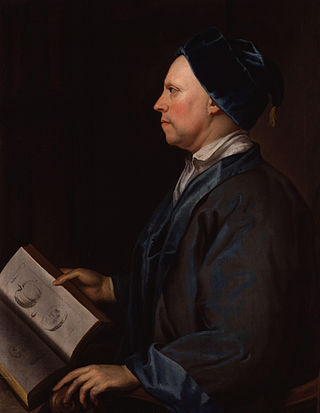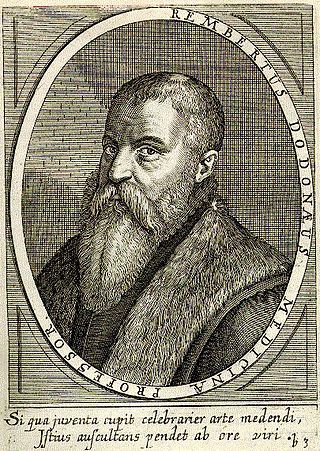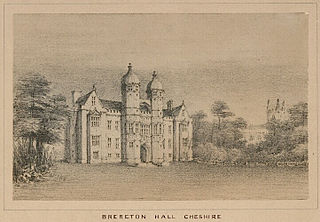
John Martyn or Joannes Martyn was an English botanist.

John Gerard was an English herbalist with a large garden in Holborn, now part of London. His 1,484-page illustrated Herball, or Generall Historie of Plantes, first published in 1597, became a popular gardening and herbal book in English in the 17th century. Except for some added plants from his own garden and from North America, Gerard's Herbal is largely a plagiarised English translation of Rembert Dodoens's 1554 herbal, itself highly popular in Dutch, Latin, French and other English translations. Gerard's Herball drawings of plants and the printer's woodcuts are mainly derived from Continental European sources, but there is an original title page with a copperplate engraving by William Rogers. Two decades after Gerard's death, the book was corrected and expanded to about 1,700 pages.

A herbal is a book containing the names and descriptions of plants, usually with information on their medicinal, tonic, culinary, toxic, hallucinatory, aromatic, or magical powers, and the legends associated with them. A herbal may also classify the plants it describes, may give recipes for herbal extracts, tinctures, or potions, and sometimes include mineral and animal medicaments in addition to those obtained from plants. Herbals were often illustrated to assist plant identification.

Sium sisarum, commonly known as skirret, is a perennial plant of the family Apiaceae sometimes grown as a root vegetable. The English name skirret is derived from the Middle English 'skirwhit' or 'skirwort', meaning 'white root'. In Scotland it is known as crummock and in Irish cearrachán. Its Danish name sukkerrod, Dutch name suikerwortel and German name "Zuckerwurzel" translate as 'sugar root'.

Rembert Dodoens was a Flemish physician and botanist, also known under his Latinized name Rembertus Dodonaeus. He has been called the father of botany. The standard author abbreviation Dodoens is used to indicate this person as the author when citing a botanical name.

Mathias de l'Obel, Mathias de Lobel or Matthaeus Lobelius was a Flemish physician and plant enthusiast who was born in Lille, Flanders, in what is now Hauts-de-France, France, and died at Highgate, London, England. He studied at the University of Montpellier and practiced medicine in the low countries and England, including positions as personal physicians to two monarchs. A member of the sixteenth-century Flemish School of Botany, he wrote a series of major treatises on plants in both Latin and Dutch. He was the first botanist to appreciate the distinction between monocotyledons and dicotyledons. The Lobelia plant is named after him.

John Parkinson was the last of the great English herbalists and one of the first of the great English botanists. He was apothecary to James I and a founding member of the Worshipful Society of Apothecaries in December 1617, and was later Royal Botanist to Charles I. He is known for two monumental works, Paradisi in Sole Paradisus Terrestris, which generally describes the proper cultivation of plants; and Theatrum Botanicum, the most complete and beautifully presented English treatise on plants of its time. One of the most eminent gardeners of his day, he kept a botanical garden at Long Acre in Covent Garden, today close to Trafalgar Square, and maintained close relations with other important English and Continental botanists, herbalists and plantsmen.
This article lists notable events in the history of botany in Britain.
John Goodyer (1592–1664) was a botanist who lived in south-east Hampshire, England, all his life. He amassed a large collection of botanical texts which were bequeathed to Magdalen College, Oxford, and translated a number of classical texts into English.

Ornithogalum umbellatum, the garden star-of-Bethlehem, grass lily, nap-at-noon, or eleven-o'clock lady, a species of the genus Ornithogalum, is a perennial bulbous flowering plant in the asparagus family (Asparagaceae). O. umbellatum is a relatively short plant, occurring in tufts of basal linear leaves, producing conspicuous white flowers, in a stellate pattern, in mid to late spring. The flowers open late in the day, but when closed have a green stripe on the outside. It is native throughout most of southern and central Europe, and north-western Africa. O. umbellatum is often grown as a garden ornamental, but in North America and other areas it has escaped cultivation and can be found in many areas, where it may be considered an invasive weed. Parts of the plant are considered poisonous, but are used in some regional cuisines. Essences are also sold as patent remedies. O. umbellatum has been depicted in art by artists such as Leonardo da Vinci, and folklore has suggested it originally grew from fragments of the star of Bethlehem, hence its horticultural name.

William Brereton, 2nd Baron Brereton was an English landowner from Cheshire and member of the Peerage of Ireland who owned estates in County Carlow. A Royalist sympathiser during the Wars of the Three Kingdoms, after the 1660 Stuart Restoration he served as joint Lord Lieutenant of Cheshire and Member of Parliament for Cheshire from 1661 to 1664.
Gerard Langbaine, the elder was an English academic and clergyman, known as a scholar, royalist, and Provost of Queen's College, Oxford during the siege of the city.

A physic garden is a type of herb garden with medicinal plants. Botanical gardens developed from them.

The history of botany examines the human effort to understand life on Earth by tracing the historical development of the discipline of botany—that part of natural science dealing with organisms traditionally treated as plants.

Sir William Savile, 3rd Baronet of Thornhill was an English politician who sat in the House of Commons between 1640 and 1642. He fought on the Royalist side in the English Civil War and was killed in action.

George Baker was an English surgeon notable for writing and translating a number of early medical texts.

John Payne (1607–1647) was an English engraver, who was one of the earliest exponents of the art of engraving in England. His best work was the finest produced by a native-born engraver working during the reign of Charles I.

Theophrastus's Enquiry into Plants or Historia Plantarum was, along with his mentor Aristotle's History of Animals, Pliny the Elder's Natural History and Dioscorides's De materia medica, one of the most important books of natural history written in ancient times, and like them it was influential in the Renaissance. Theophrastus looks at plant structure, reproduction and growth; the varieties of plant around the world; wood; wild and cultivated plants; and their uses. Book 9 in particular, on the medicinal uses of plants, is one of the first herbals, describing juices, gums and resins extracted from plants, and how to gather them.

Spiced ale refers to traditional ales flavored with non-traditional spices and herbs. Spiced ales are sometimes brewed as a seasonal beer, such as during the time of Christmas or other holidays.
















